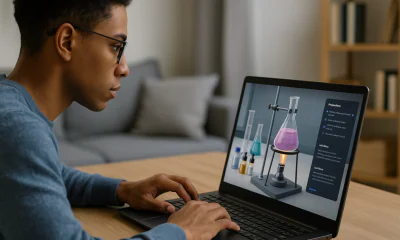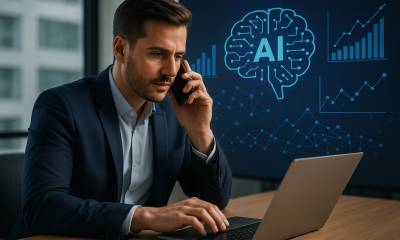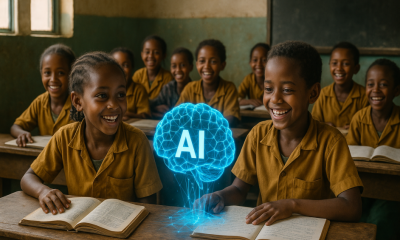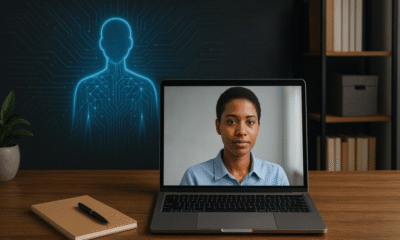Thought Leaders
AI and Educational Equity: A Blueprint for Closing the Gap

In an ideal world, everyone would have the same opportunity for a quality education. However, the reality is far from this view. There are differences in the status and quality of education related to factors such as socioeconomic status, cultural barriers and language barriers. Although we live in an age of unprecedented technological and social progress, differences in possession, the gap between more educational opportunities and less access is largely the result of failed policies.
As if things weren’t bad enough, the COVID-19 pandemic made it more difficult. In a time where we rely very heavily on technology and its byproducts, not everyone has the luxury and the privilege of having access to them. This has further increased the education inequity gap. Although technology has the potential to make education easier to access for everyone, it can also act as a barrier that worsens inequity, especially for those already at a disadvantage.
This blog is going to explore the complex topic of how artificial intelligence (AI) can help make education fair for everyone. We’ll go beyond the usual conversations and think of other creative ways that AI can help us make schools better and more equitable for everyone in the future.
Education “inequality” and “inequity” are often used interchangeably but for the sake of this blog it’s important to make the distinction in the context of education. Inequality describes the uneven distribution of educational outcomes, while inequity indicates when these inequalities are unfair and systematic. Basically, inequality is a symptom, but inequity is the problem we aim to solve. In this blog, we specifically focus on using AI to address educational inequities.
The Current State of Educational Inequity: Hard Facts
Globally, 258 million children, adolescents, and youth are not in school. This number isn't uniform across regions: 31% of young people are out of school in sub-Saharan Africa and 21% in Central Asia, compared to only 3% in Europe and North America. These figures demonstrate the stark disparities in educational access between developed and developing nations.
But even attendance doesn't capture the full picture. Learning outcomes, or what students are actually able to understand and do, reveal another layer of inequity. In Brazil, for example, it would take 15-year-olds 75 years to catch up to the average math scores of their counterparts in wealthier countries, given the current pace of educational improvement. For reading, this gap widens to an estimated 260 years.
In-country inequities further illustrate the point. In Mexico, 80% of indigenous children finishing primary school do not reach basic competency levels in reading and math. These students are falling further behind and the gap widens in educational achievement.
These numbers are more than just data points; they are indicators of real, systemic issues that require attention and action.
Causes of Educational Inequity: Digging Deeper
Educational inequity is a complex issue that stems from a variety of factors. To understand the root causes, we need to go beyond surface-level observations and delve into the mechanisms that perpetuate this systemic problem.
Resource Allocation: Primary cause of education inequity is the skewed distribution of educational resources. Unfortunately, education has become the political grounds for students in many countries which has caused the resources to be allocated to where most of the political pressures are rather than the area that needs resources the most. Such attention usually stems from urban communities or those with a dominant cultural or educational background. Consequently, schools located in financially challenged or remote localities, or those primarily serving underrepresented communities, are at a disadvantage when it comes to things like facilities, materials, and qualified educators.
Teacher Training: Teachers are crucial in determining the success of educational programs. If insufficient focus is placed on both initial and ongoing training for teachers, the result is often gaps in student learning. This problem is pronounced in areas where teachers per capita is significantly lower and access to quality education for these educators are more scarce.
Curriculum Relevance: The diversity of a country often comes into conflict with a one-size-fits-all educational curriculum. Students from rural areas or cultural minorities, or those living in poverty, often find the standardized curriculum irrelevant or meaningless. This mismatch is exacerbated when the language of instruction differs from the students' native languages, leading to reduced learning and higher dropout rates.
Social Factors: Prejudices, stereotypes, and sometimes even overt racism and sexism, can also contribute to educational inequity. Disadvantaged students often encounter negative attitudes from teachers and classmates, affecting their willingness to learn and increasing the likelihood of early dropout.
Each of these factors is not just an independent issue but part of an interconnected web that feeds into the larger system of educational inequity. Addressing this complex challenge requires a multi-faceted approach, which we will explore in the subsequent sections.
Why AI Can Make a Difference in Addressing Educational Inequity
Artificial Intelligence has the potential to revolutionize how we approach educational inequity by offering solutions that are both scalable and personalized. Take resource allocation, for instance. AI-driven analytics can identify underserved schools and student populations, enabling governments and educational institutions to distribute resources more equitably. This data-driven approach can apply pressure where it's most needed, rather than where it's most politically expedient.
In terms of teacher training, AI can facilitate remote learning and professional development opportunities, breaking down the geographical barriers that often leave educators in impoverished or rural areas without access to quality training. This amplifies the human capacity to teach by equipping educators with the skills and support they need to be effective, irrespective of their location.
As for the curriculum, AI-powered adaptive learning systems can personalize education to suit the individual needs of each student. This is especially crucial for students from diverse backgrounds, who may find a “one-size-fits-all” curriculum irrelevant or challenging. These intelligent systems can even adapt the language of instruction, bridging gaps that may otherwise lead to reduced learning and higher dropout rates.
Lastly, AI can mitigate the social factors contributing to educational inequity. Intelligent systems can be designed to be culturally sensitive, avoiding the biases and prejudices that might otherwise be perpetuated in educational settings. These systems can also identify patterns of discrimination or bias, alerting administrators to issues before they escalate, thus fostering a more inclusive educational environment.
A Vision for the Future: AI Transforming a Rural School District
Imagine a rural school district where educational disparities are starkly evident. Teachers are undertrained, resources are scarce, and societal prejudices persist. To tackle these issues head-on, the district integrates a cutting-edge AI educational system, resembling platforms like Penseum.
Right off the bat, the AI platform performs a thorough needs assessment. It combs through data on student grades, attendance records, and even local demographic factors. This nuanced understanding allows school authorities to shift resources where they're most needed.
Teachers get personalized professional growth opportunities through a dedicated portal. No matter where they are in their career, the platform serves up relevant training and even remote mentorship, enabling them to become more effective educators.
For the students, an adaptive learning platform reshapes their educational experience. It customizes lessons based on a detailed profile of each student’s strengths, weaknesses, and learning preferences. Additionally, it alerts educators about students who might be veering off course, enabling timely interventions.
But that's not all. As the academic year unfolds, the platform also begins to spot more subtle problems, like implicit biases in evaluations and imbalances in resource distribution. School administrators are notified, and remedial steps are immediately taken. Teachers can access specialized training to counteract unconscious biases, ensuring a more equitable learning environment for everyone.
This isn't just technology for the sake of technology; it's a holistic approach to dismantling the barriers that perpetuate educational inequality. Over time, the district evolves, becoming a blueprint for how platforms like Penseum can democratize education, making it more equitable and inclusive.
Drawing Parallels: AI in Healthcare as an Adjacent Scenario
When considering the transformative potential of AI in education, it might be instructive to examine its applications in healthcare, another sector fraught with systemic inequities. Just like in education, the healthcare system faces challenges like resource allocation, access to quality services, and cultural biases, among others. AI has already started to make inroads in addressing some of these issues in healthcare, offering promising implications for its application in the educational sphere.
For instance, IBM's Watson Health has developed AI-driven predictive analytics tools that help healthcare providers make informed decisions. These tools analyze vast amounts of patient data to identify trends or flag risks that might otherwise go unnoticed. In this way, healthcare resources can be allocated more efficiently, prioritizing those most in need—much like how AI in education can help allocate resources to disadvantaged schools or districts.
Similarly, companies like Zebra Medical Vision have been pioneering in the field of medical imaging. Their AI algorithms can analyze medical images and spot potential anomalies, which is particularly useful in regions that lack the expertise in radiology. The technology, thus, has the power to democratize access to quality healthcare diagnostics, just as AI has the potential to democratize education through tailored learning experiences.
Google's DeepMind has developed an AI system that can identify eye diseases in scans, providing early detection that could prevent more severe vision loss down the line. This is especially significant for under-resourced communities where such medical expertise is lacking. By the same token, AI systems in education could offer early detection of learning disabilities, enabling timely interventions that could make a substantial difference in a child's academic trajectory.
By examining these real-world applications of AI in healthcare, we can begin to construct a vision for how similar technology could be leveraged to combat inequities in the educational system. Both sectors share the imperative to serve diverse populations fairly and effectively, and in both cases, AI offers tools that can help achieve this goal.
Challenges and Ethical Considerations: The Dual-Edged Sword of AI
While the applications of artificial intelligence hold immense promise for bridging gaps in educational equity, there are important challenges and ethical considerations that cannot be ignored. The excitement surrounding this technological frontier must be tempered by critical examinations of its potential downsides, many of which can inadvertently exacerbate existing inequalities.
Firstly, data privacy stands as a major ethical concern. Educational systems hold sensitive information about students, including academic records, socio-economic status, and even behavioral assessments. As AI systems require large datasets to function effectively, the question arises: Who owns this data, and how secure is it? Mishandling of such information could have serious repercussions, potentially violating students' privacy or enabling unauthorized profiling.
Another concern revolves around the quality and fairness of algorithms. As human biases can be coded into these algorithms, we run the risk of perpetuating, or even amplifying, existing prejudices. Whether it's racial, economic, or gender biases, AI systems could inadvertently favor one group over another, thereby worsening the educational divide rather than alleviating it.
The accessibility of AI tools is another major issue. Schools in affluent neighborhoods are more likely to afford advanced AI-based educational systems, potentially widening the gap between them and underfunded schools. Unless there are concerted efforts to democratize access to these technologies, the potential for AI to serve as an equalizing force in education remains compromised.
Moreover, there's the question of teacher and student autonomy. While AI can be a helpful tool, there's a very real concern that over-reliance on algorithms could undermine the role of educators in crafting curricula and evaluating student progress. Similarly, while personalized learning paths created by AI can benefit students, they could also create an overly structured environment that stifles creativity and independent thought.
Lastly, there's a lack of long-term studies examining the efficacy and ethical implications of using AI in education. This creates a knowledge gap that makes it difficult to forecast the unintended consequences of integrating these technologies into educational settings.
While AI offers a tantalizing possibility for improving educational equity, it also poses a series of ethical and practical challenges that need to be thoughtfully addressed. Recognizing these challenges is not an argument against the use of AI in education but a call for a more nuanced, ethically responsible approach to its implementation.
A Balanced View on the AI-Education Nexus
As we explore the transformative possibilities of AI in the educational landscape, it is crucial to adopt a balanced perspective. Artificial intelligence holds significant promise for addressing many of the systemic inequities that plague education systems globally. From personalized learning pathways to more equitable resource allocation, the potential benefits are both sweeping and impactful. However, this is not a one-sided narrative. The complexities of introducing AI into such a delicate ecosystem, fraught with ethical and logistical pitfalls, cannot be overstated.
While AI can be a powerful tool for augmenting educational quality and fairness, its implementation requires a cautious approach. We must engage in constant ethical scrutiny, ensuring that privacy is protected, biases are mitigated, and access is democratized. At the same time, safeguarding the roles of teachers and students as active, creative participants in the learning process is non-negotiable. The absence of long-term empirical studies on the subject calls for an ongoing commitment to research and evaluation, as we step into this largely uncharted territory.
In essence, the journey towards integrating AI in education is much like navigating a complex maze. Each turn presents opportunities and challenges, and while the destination—a more equitable educational landscape—is compelling, the path to get there is fraught with questions that demand thoughtful answers. Ignoring these questions is not an option; instead, they should serve as guideposts, shaping a more informed, ethical, and ultimately, effective application of AI in education. Only then can we hope to fulfill the technology's promise without falling prey to its perils.












